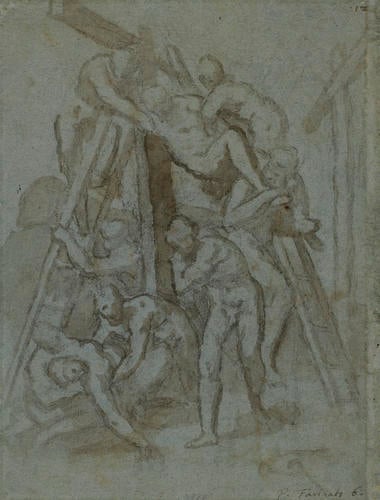-
1 of 253523 objects
Christ on the Cross, with Saint Francis and Saint Anthony of Padua
Pen, ink and wash over black chalk on blue paper, heightened with white | 26.9 x 20.6 cm (sheet of paper) | RCIN 904988

Paolo Farinati (1524-1606)
Christ on the Cross, with Saint Francis and Saint Anthony of Padua

Paolo Farinati (1524-1606)
Christ on the Cross, with Saint Francis and Saint Anthony of Padua


-
Active in and around Verona, the Mannerist painter, sculptor and architect Paolo Farinati (1524–1606) produced many decorative cycles for private residences, as well as works for churches in Verona. Although influenced by Veronese’s use of chiaroscuro, it was artists from Emilia, Mantua and Central Italy that had the strongest influence on Farinati’s work. His drawings reflect the animated compositions and figures of Giulio Romano (c.1499–1546), as well as the powerful muscularity of Michelangelo (1475–1564), whose work he would have encountered through reproductions.
On the recto of the sheet is a study of Christ’s crucifixion with Saint Francis and Saint Anthony (identifiable by the lily he holds). There is evidence of preparation for squaring at the bottom of the sheet, suggesting it was being prepared for transfer and that the sheet was preparatory study for a painting or fresco. A connected work has not yet been identified. Outside Farinati’s hand drawn framing lines is a rough pen sketch of a bearded head, possibly a draft for the head of St Francis. Farinati has given clear thought to the quality of the fabric worn by the two saints, depicting St Francis’ robe as patched.
On the verso is a study for the Deposition. Three figures are shown lifting Christ from the cross, below them the Virgin Mary is fainting. Drawn first in black chalk and then in brush and wash, this study is unusual in the absence of pen and ink outlines and shading which elsewhere characterise Farinati’s work. The study demonstrates Farinati’s method of working; depicting the figures first in the nude, focusing on the anatomy of their bodies, before modelling drapery in pen and ink. Through this process Farinati was able to achieve a powerful muscularity and articulate the three-dimensional form of the bodies beneath the robes, as seen on the recto of this sheet.
The sheet has been inscribed in the lower right corner with Farinati’s name and a price by the art dealer William Gibson (1644/5–1702). William Gibson's inscriptions and characteristic price codes can be found on 14 of the 47 drawings by Farinati in the Royal Collection. Gibson seems to have had a preference towards drawings from the muscular strand of Italian draughtsmanship exemplified in Farinati’s work.
It is probable that most, if not all, were acquired during the reign of Charles II. A list of albums at Kensington Palace in 1727 includes one volume of drawings by Farinati and his followers, in which this sheet was housed. The album contained RCINs 904973–905026, with other sheets by Farinati housed in a miscellaneous album. These volumes were subsequently broken up and the drawings were mounted separately.
The Royal Collection holds another sheet by Farinati on paper with an anchor watermark (RCIN 904993).
Provenance
William Gibson; probably acquired by Charles II; listed in George III's 'Inventory A,' c.1800-20, p. 117, Paolo Farinati ‘A Spirited manner & not wanting in Invention but not correct in his Drawing.’
-
Medium and techniques
Pen, ink and wash over black chalk on blue paper, heightened with white
Measurements
26.9 x 20.6 cm (sheet of paper)